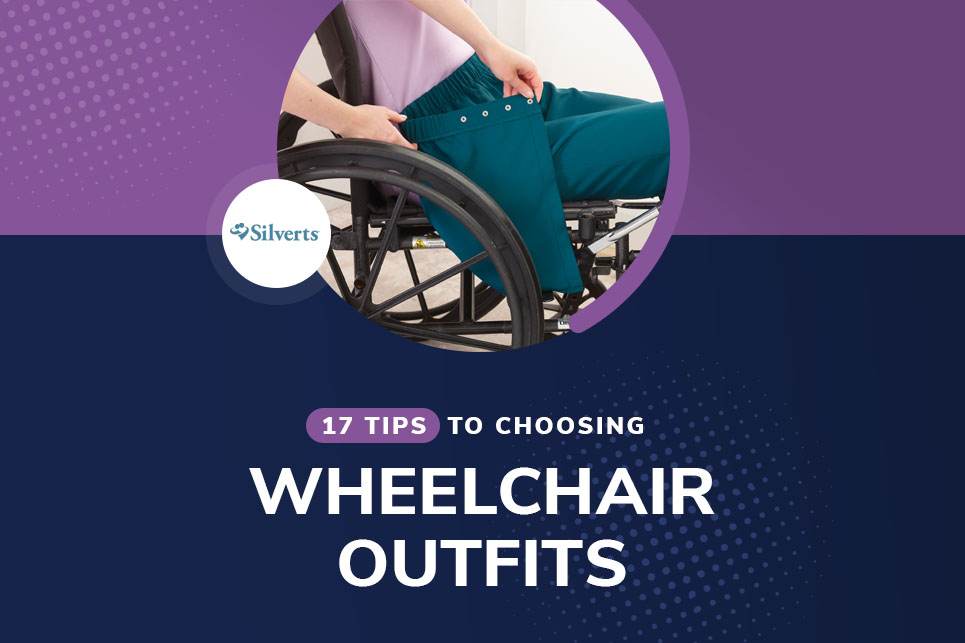17 Tips to Choosing Wheelchair Outfits
Shopping for clothes can be a challenging experience for many people. This exercise can be even more frustrating when looking for wheelchair outfits, since there are many considerations wheelchair users must take into account when shopping for clothing. It’s not just style and ease of dressing that this demographic relies on for effective garments, but choosing the wrong garments can contribute to the formation of pressure sores, for example. Here are 17 tips to follow when looking for adaptive clothing for wheelchair users:
Prioritize your specific needs
Each wheelchair user has unique needs and requests, which need to be taken into consideration when shopping for wheelchair outfits. For example, some people need medical ports in their clothing, while others do not. Some people find it more comfortable to wear adaptive clothing for wheelchair users specifically, while others prefer traditional clothing. Your needs can also change over time–and activity, such as if you can do , then you may want activewear. Periodically assess your closet to figure out what garments are or aren’t working for you anymore and why that is.
Choose from assisted or self-dressing garments
Silverts Adaptive clothing is divided into two main categories: self-dressing and assisted-dressing. Self-dressing clothing is meant for people who can dress themselves with the help of adaptive features like magnets, while assisted clothing is meant for people who need someone else’s assistance getting dressed. Switching to self-dressing adaptive clothing can help you maintain your independence for longer. This clothing may also enable you to dress yourself with minimal help even if traditional clothing is a struggle. On the other hand, assisted dressing clothing will make the dressing process easier on both you and your caretaker, helping to reduce stress and possible injury for you both.

Try out open-back garments
Open-back clothing features two fabric panels in the back that completely overlap. These items were designed to make the dressing process as easy as possible for a wheelchair user and their caregiver, while preserving the wheelchair user’s dignity and comfort. Because the panels completely overlap, you never have to worry about accidentally exposing yourself, while still being able to get out of the clothes quickly (with help) when you need to. At Silverts, we sell a wider variety of open-back clothing to suit a variety of needs, including shirts, pants and adaptive dresses that are both casual and formal.
Check fit while sitting down
If you only use your wheelchair part-time, then it’s vital that you check the fit of your clothes while sitting down, as well as while standing up. Clothing that fits well while standing may shift, chafe or cut into your skin when you are sitting down, making for a highly uncomfortable experience. All adaptive clothing for wheelchair users should be comfortable to wear while sitting or lying down all day. Another option for added protection and comfort for people who wear skirts, is to layer adaptive shorts or leggings underneath your outfit to ensure added modesty throughout the day.
Select comfortable, breathable fabrics
Stiff and thick fabrics become more uncomfortable when you have to sit in them all day. Wheelchair users should look for soft, thin fabrics that are made of natural fibers such as cotton, which allow their skin to breathe. Synthetic fabrics such as polyester and nylon will trap sweat, which can lead to skin irritation and rashes. You should wash your clothes in gentle, fragrance-free detergent. Avoid detergents, fabrics softeners and other products that are full of dyes, fragrances and other harsh chemicals that could potentially irritate your skin.
Make sure tops give you room to move
If you wheel your own chair, then you want to ensure clothing has extra space in your shoulder and chest area so that you can move your arms freely. Constricting fabric can also impede circulation, which you definitely want to avoid. When you try on a top or shirt, move your arms around in exaggerated motions to ensure that you have enough room to maneuver.

Choose dark-colored bottoms
To save both aggravation and laundry use, stick with darker colored bottoms. White jeans or light-colored pants might look good hanging in your closet, but they will be less appealing once they are covered with lint and dirt from wheelchair splatter — not to mention it’s a pain to try to get these stains out. Instead, choose dark-colored bottoms in colors such as black, navy and gray, which will hide stains and dirt and make you look more put together throughout the day. If you prefer light-colored garments, then you can pair your dark-colored bottoms with a lighter top for some contrast.
Be careful with tight waistbands
Stiff waistbands and belts are a huge source of discomfort for wheelchairs users, so we recommend avoiding them altogether. Instead, choose pull-on pants with elastic waistbands that will easily expand to accommodate any bloat or swelling without putting any pressure on your stomach. Thankfully, pull-on pants have become very stylish these days, so there are many different options to choose from.Some pull-on pants, such as those sold at Silverts, also feature discreet pull tabs inside the waistband to make the garments even easier to take on and off.
Watch for excess fabric
Excess fabric is a concern for wheelchair users for several reasons. Not only does it bunch up — causing chafing and discomfort — but it also presents safety concerns because it can drag on the ground or get caught in the wheels of the chair. While you don’t want your clothing to be too tight, you should also avoid very long or drapey clothing that incorporates a lot of excess fabric. Look out for both sleeves and pants that are too long, as well as flowy tops and sweaters that may bunch up uncomfortably in the back when you sit down.

Pick the right hem length
When you are sitting down, clothing moves around and doesn’t fit the same as when you are standing. When sitting, pants and tops might bunch up in the front while exposing skin in the back, and pant hems can shift to expose your socks. This is why some wheelchair users prefer shirts and pants that have a longer hem or higher waistband in the back. These adaptive garment styles provide extra coverage and protection so the wearer does not have to worry about their lower back and legs being exposed. You should also choose pants with a slightly longer hem that hits right at your ankle when you are sitting down (unless you are trying to intentionally show off a cool pair of socks, that is!).
Look for low profile seams
Pressure sores are a concern for nearly all wheelchair users, and seams can often create pressure injuries as well as chafing. To reduce your chances of developing pressure sores, choose clothing with low-profile seams or even a seamless design. Sometimes you might see this clothing described as “sensory friendly” as well, so look out for that terminology. Also, pay attention to how thick and scratchy the seams are and where they are located. Any seams that you sit on should be avoided, if all possible, since those will apply the most pressure to your body.
Decide if you need medical device ports
Some wheelchair users need to access medical devices such as catheters or prosthetics. Since traditional clothing was not designed with these needs in mind choosing wheelchair adaptive clothing that has built-in ports can make a big difference for you and your caretakers. These access ports are designed to be discreet and are typically located against existing seam lines so that they are as unobtrusive as possible. The ports typically close with low-profile snaps or zippers so that they remain closed when not in use but can be quickly opened for easy access them.
Choose innovative closures
Standard closures, such as buttons can be difficult to operate, which is why clothing for people with disabilities use innovative closures instead. For example, snaps, zippers and magnetic “buttons” are easier for people with limited dexterity, since they can sometimes be operated with one hand. Pull-on styles are another great option, since these styles are closure-free However, these products may require more range of motion to take on and off, especially when it comes to shirts.
Check the pocket placement
Back pockets can create pressure points and cause chafing, not to mention the difficulty in accessing these back pockets for someone who is sitting in a wheelchair . If you buy traditional pants with back pockets — especially jeans or another thick fabric — to increase your comfort you may want to remove the back pockets using a seam ripper.
While hip pockets in the front are less likely to cause pressure and chafing, wheelchair users report experiencing similar access problems. A great option is to look for pants with thigh pockets that are easily accessible while sitting and won’t chafe. These pockets are more useful and more comfortable, making them a win for wheelchair users.

Don’t forget about shoes
Wearing shoes is important to protect your feet and complete your outfit, even if you won’t be walking around. Many people in wheelchairs enjoy wearing slippers for comfort, but plenty also enjoy sneakers, boots and other styles of shoes. At Silverts, we sell many different styles of adaptive footwear that provide all-day comfort, so that you don’t have to choose between feeling good and looking good.
Accessorize your outfits
Accessories for wheelchairs can be fun or functional (or both!). With practical accessories, wheelchair blankets can help keep you warm during cold weather, while socks will protect your ankles from the elements. You can also add other accessories, such as a hat or scarf, to make your outfit more fun and add a pop of color or some visual interest. Many wheelchair users rotate through the same go-to outfits, and accessories can help add variety to an outfit.
Find your own sense of style
Many people in wheelchairs understandably focus on the practical aspects of getting dressed, but that doesn’t mean that you have to sacrifice function for fashion! Don’t be afraid to experiment with different colors and styles to see which ones you feel best in. And don’t assume that all wheelchair clothing is frumpy or boring — at Silverts, we offer many different styles for both men and women that look almost identical to traditional clothing, including jeans, button-up shirts, sweaters, knit pants, summer dresses and more.
Ready to order new wheelchair outfits? Shop adaptive clothing at Silverts and get free shipping on your domestic U.S. order, plus a 100% money-back guarantee and 60-day returns so that you can shop with confidence.
Image Credits
NeelRong/Shutterstock.com
NOK FreeLance/Shutterstock.com





No Comments